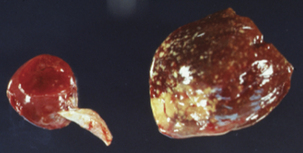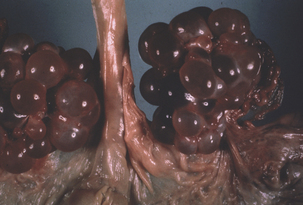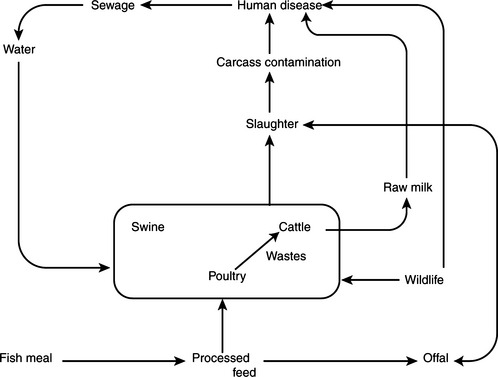Chapter 16 The Genus Salmonella
Members of the genus Salmonella colonize vertebrate hosts, with outcomes ranging from subclinical to systemic infection with high mortality. Animal infection has direct economic consequences, but asymptomatic carriage, leading to direct or indirect transmission to humans, may be even more important.
The genus comprises nearly 2500 serovars, traditionally based on the Kauffman-White scheme in which H (flagellar) and O (somatic) antigens determine the serovar. However, multilocus enzyme electrophoresis and DNA–DNA hybridization analysis revealed that the genus can be divided into two species, Salmonella enterica (2443 serovars) and Salmonella bongori (20 serovars). Salmonella enterica is divided into subspecies salamae, arizonae, diarizonae, houtenae, indica, and enterica. The last contains most of the approximately 50 serovars that cause most disease cases. Salmonella bongori serovars lack Salmonella pathogenicity island–2 (SPI-2) (see p. 134). The type species remains officially Salmonella choleraesuis, but the two-species concept, with S. enterica as the type species, is increasingly accepted. Nonitalicized serovar names are retained.
DISEASES AND EPIDEMIOLOGY
Outbreaks of disease in animals and humans have been associated with Salmonella Newport since the 1970s. The organism has emerged as an important cause of diarrhea outbreaks in horses and dairy cattle, with high mortality in periparturient and neonatal animals. The serovar has consistently been ranked among the 10 salmonellae most commonly isolated from human food-borne infections, having been recovered from hamburger, chicken, roast beef, potato salad, pork, alfalfa sprouts, and seafood. Multidrug resistance is a major problem, with resistance described to chloramphenicol, sulfamethoxazole, tetracycline, strep tomycin, and most recently to cephalosporins.
Salmonella Gallinarum and Salmonella Pullorum cause septicemic disease in turkeys (fowl typhoid) and chickens, respectively, but these birds are infected with a wide variety of serovars. Young chicks often develop fatal septicemia (Figure 16-1), and Salmonella Enteritidis phage type 4 causes a lethal infection in older chickens (Figure 16-2). Salmonella enterica ssp. arizonae is a common problem in turkeys. Even where the traditional avian pathogens S. Gallinarum and S. Pullorum have been eliminated, poultry are frequently colonized with one or more serovars, including Typhimurium, Enteritidis, Heidelberg, Infantis, Montevideo, and Anatum, any of which may be transmitted to humans. Vertical transmission, especially of S. Enteritidis, S. Typhimurium, and Salmonella Heidelberg, makes eggs a common vehicle for human infection.
Equine salmonellosis is an uncommon but nonetheless important problem, especially as a nosocomial infection in veterinary teaching hospitals. Many strains isolated from this setting are resistant to multiple antimicrobials. The infectious dose is apparently quite small in horses that have been exposed to the stress of transportation and are affected by underlying illness. Salmonella Typhimurium is encountered most frequently, but others implicated in disease include Agona, Krefeld, Anatum, and Saint-Paul. Foals are more susceptible than adults, often developing septicemic disease.
Salmonellae reside in the normal vertebrate gastrointestinal tract, and asymptomatic carriers among domestic and wild animals and birds introduce the infection to and maintain it in herds and flocks (Figure 16-3). Feeds of animal origin (fish meal, bone meal, and meat meal) and contaminated water are also common sources of infection. Long-term survival in manure, soil, and other aspects of the environment facilitate transmission. Turtles, lizards, and snakes, as well as sick and recovering humans may shed organisms. Other sources are whole eggs (duck eggs may have a higher prevalence of infection) and egg products, meat and meat products, contaminated water, contaminated equipment and utensils, fertilizers, and animal feeds prepared from bones, fish meal, and meat. Biosecurity is also often compromised by Salmonella-carrying rodents and wild birds.
< div class='tao-gold-member'>
Stay updated, free articles. Join our Telegram channel

Full access? Get Clinical Tree





